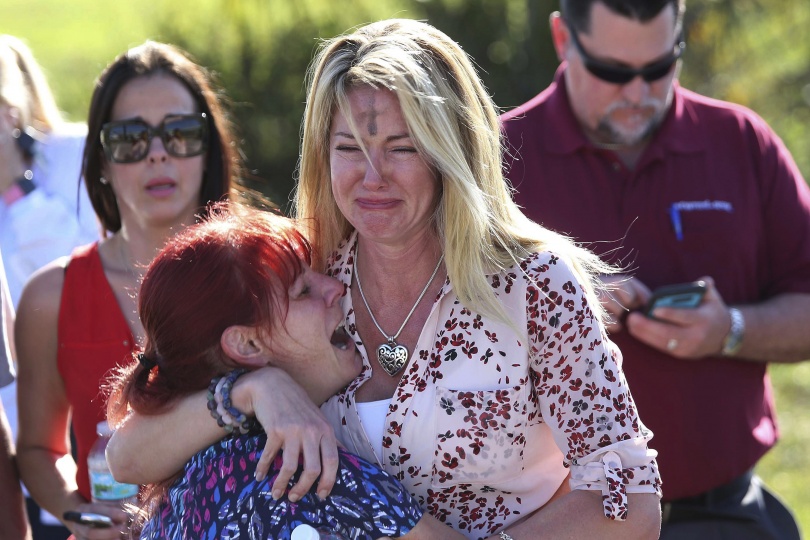Stoneman Douglas School Shooting: Reporting Resources
Seventeen students and teachers were killed by a gunman at Marjory Stoneman Douglas High School. Please consult our resources in covering this tragedy and its aftermath.

Parents wait for news after a reports of a shooting at Marjory Stoneman Douglas High School in Parkland, Florida, on Wednesday, Februrary 14, 2018.
Seventeen students and teachers were killed by a gunman at Stoneman Douglas High School earlier this month in one of the most deadly mass shootings in United States history.
The gunman, a 19-year-old who had been expelled from the school, was armed with a semiautomatic AR-15 rifle, a gun that has been used in six of the 10 deadliest mass shootings in modern U.S. history.
COVERING GUNS & GUN VIOLENCE
Expert briefing materials, transcripts, video, reporter tipsheets, Q&A’s with panelists and an array of links to other resources created following Dart Center workshops on covering gun violence in Arizona and Chicago.
In this video James Grimaldi, investigative reporter at the Wall Street Journal, gives a hard-hitting talk on how to investigate gun sales.
Naming Killers? Families of mass shooting victims ask media to limit use of shooters' names.
Firearm Terminology and Vocabulary: A basic guide for describing firearms, accessories, and safety or regulatory technologies.
ATF Crime gun trace data: state-level data only but can be obtained for earlier years by public record request.
Fact Sheet by National Shooting Sports Foundation: Why the Firearms Industry Opposes Background Checks.
National Violent Death Reporting System: NVDRS is the only state-based surveillance reporting system that pools data on violent deaths from multiple sources into a usable, anonymous database. These sources include state and local medical examiner, coroner, law enforcement, crime lab, and vital statistics records.
Gallup Poll on household gun ownership.
COVERING CHILDREN AND TEENAGERS
Quick tips for interviewing children.
The Dart Center's comprehensive guide, "Covering Children and Trauma."
The National Child Traumatic Stress Network's resources on responding to a school crisis, suggestions for educators, suggestions for talking to children, tips for youth talking to journalists, parent guidelines for helping youth, age-related reactions to a traumatic event, and psychological impacts to consider following a recent shooting.
Substance Abuse and Mental Health Services Administration's Tips for Talking to Children and Youth After Traumatic Events.
American Psychological Association's guide to help children manage their distress following a school shooting.
A fact sheet on the effects of trauma-related news media on children.
An overview of current research on the impacts of media coverage of tragedy on children.
Oklahoma University's Terrorism & Disaster Center
COVERING MASS KILLINGS
Psychiatrist Frank Ochberg, M.D. and Bruce Shapiro, executive director of the Dart Center, share insights on covering mass killings in the aftermath of the 2011 Arizona shooting that left six dead and a U.S. Congresswoman grievously injured.
Reporter Dave Cullen's lessons from a decade of reporting on the Columbine attacks.
A self-study unit on covering terrorism.
A compilation of journalist-to-journalist advice, from those who have covered large-scale shootings.
Professor Meg Moritz shares four lessons on covering school shootings.
Quick tips on working with victims and survivors from Dart Centre Asia Pacific.
A guide to handling traumatic user-generated content in the newsroom from Dart Centre Europe.
Resources for Covering Mass Shootings: The Dart Center's Gavin Rees reflects on the 2010 Cumbria Tragedy and offers resources for journalists.
In a piece for Walkley magazine, the Dart Center's Bruce Shapiro points to some of what we've learned from covering mass shootings.
"Tragedies and Journalists": the Dart Center's comprehensive guide for reporters, editors, photographers and managers on every aspect of covering tragedy.
"Best Practices in Trauma Reporting," drawn from a decade of Dart Award-winning stories.
Scientific consensus, made readable, on the effects of traumatic coverage on journalists and on media consumers.
The International Center for Journalists's guide on Journalism and Trauma.
Recovery from Unnatural Death: A guide by psychiatrist Ted Rynearson for friends and family of someone who has died violently or suddenly.
ADVICE FOR EDITORS
Tips for managers and editors to help them prepare and support reporters in the field.
Dart Center Executive Director Bruce Shapiro passes on lessons for newsrooms learned from the Virginia Tech shooting.
Quick tips on how to support your reporters.
SELF-CARE
Quick tips on self-care from Dart Centre Asia Pacific.
Self-care advice from an editor who's been there.
































































































